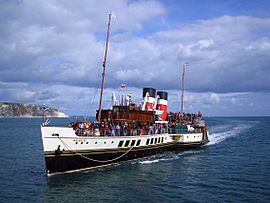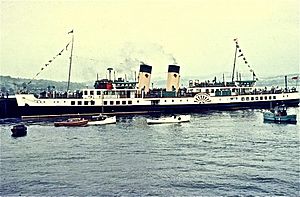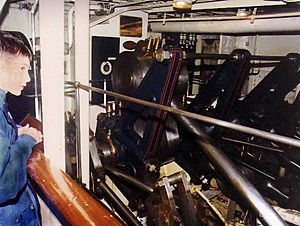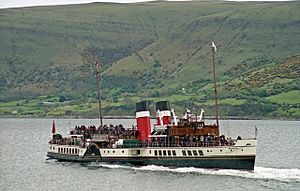PS Waverley facts for kids

Waverley at Swanage
|
|
Quick facts for kids History |
|
|---|---|
| Name | PS Waverley |
| Owner | Since 1974: Paddle Steamer Preservation Society |
| Operator |
|
| Builder | A. & J. Inglis, Glasgow |
| Yard number | 1330P |
| Launched | 2 October 1946 |
| Maiden voyage | 16 June 1947 |
| Identification |
|
| Status | Out of season; returning to service in 2021 |
| General characteristics | |
| Class and type | Coastal excursion paddle steamer |
| Tonnage | 693 grt |
| Length | 239 ft 11 in (73.13 m) s |
| Beam | 57 ft 3 in (17.45 m) s |
| Draught | 6 ft 3 in (1.91 m) s |
| Installed power | 2,100 ihp (1,566kW) |
| Propulsion | Diagonal triple expansion steam engine built by Rankin & Blackmore Ltd, Greenock |
| Speed |
|
| Capacity | Up to 925 passengers in Class V waters. |
The PS Waverley is a special ship. She is the last seagoing paddle steamer in the world that still carries passengers. Built in 1946, she used to sail on the Firth of Clyde in Scotland.
In 1973, a group called the Paddle Steamer Preservation Society (PSPS) bought her. They worked hard to bring her back to her original 1947 look. Now, Waverley takes people on fun trips around the British coast.
Since 2003, Waverley has been part of the National Historic Fleet. This means she is a very important ship in the history of the United Kingdom. In 2019, she needed new boilers, and people raised lots of money to help. She returned to service in 2020.
Contents
History of the Waverley
The PS Waverley is named after a book by Sir Walter Scott. She was built in 1946 to replace an older ship. The first Waverley was sunk in 1940 during World War II. She was helping to rescue soldiers from Dunkirk.
The new Waverley was built in Glasgow by A. & J. Inglis. She was launched in October 1946. In June 1947, she started sailing for the London and North Eastern Railway. Her route was from Craigendoran Pier to Arrochar on Loch Long. At first, her funnels were red, white, and black.
In 1948, the railways in Britain became national property. This meant Waverley joined the Caledonian Steam Packet Company (CSP). Her funnels were then painted yellow with a black top. Later, in 1965, red lion symbols were added to her funnels. Until 1970, her hull was painted a deep blue colour.
In the 1960s, fewer people took holidays on these ships. Many small piers closed down. In 1973, the CSP company merged with another, becoming Caledonian MacBrayne (CalMac).
Saving the Waverley
CalMac decided to stop using Waverley after the 1973 season. She was too expensive to run and needed a lot of repairs. Luckily, the Paddle Steamer Preservation Society (PSPS) stepped in. This group is a charity that saves old ships.
CalMac sold Waverley to the PSPS for just one pound! They wanted to make sure the ship was saved. Many people thought she would never sail again. But the PSPS launched a public appeal to raise money.
They successfully raised enough funds to fix Waverley. The PSPS then started running "Waverley Excursions" to take passengers on trips. Since then, Waverley has had many big repairs and improvements. This includes new boilers and updates to meet modern safety rules. She has even sailed all the way around Great Britain!
Between 2000 and 2003, the ship had a huge rebuild. This was paid for by the Heritage Lottery Fund. The work added new safety features and technology. It also made the ship look exactly like she did in 1947.
In 2011, Waverley received a special award. It was the 65th Engineering Heritage Award from the Institution of Mechanical Engineers. This shows how important her engines and design are.
How the Waverley Works
Waverley is powered by a special steam engine. It's called a triple-expansion marine steam engine. It was built by Rankin & Blackmore in Greenock, Scotland. This engine is very powerful, with 2,100 horsepower.
During her trials in 1947, Waverley reached a speed of about 18.37 knots. That's pretty fast for a paddle steamer! Passengers on board can actually watch the engines working. There are walkways on both sides of the engine room.
The main part of the engine is connected to both paddle wheels. This means the wheels turn together. Because of this, Waverley needs a lot of space to turn around. Much more than modern ferries.
Waverleys Look
Waverley has had different looks over the years. When she was first launched, the boxes around her paddle wheels were black. They changed to white in 1959, then back to black with white edges, and finally all black.
The two gold stripes along her hull were removed in 1954. But they were put back during her big rebuild in 2000. Today, Waverley looks like she did in 1947. Her funnels are red, white, and black. The upper part of the ship is painted to look like wood. Her paddle-wheel boxes are black with gold letters.
When she was new, Waverley had square windows. Now she has round portholes. The ship is checked and painted every year. This keeps her looking good and safe for sailing.
Since 1962, Waverleys funnels were a bit crooked. This was fixed during the 2000-2003 rebuild. Now, her two funnels stand perfectly straight and parallel.
Where Waverley Sails
Waverley takes passengers on trips from many ports in Britain. She often sails from Glasgow and other towns on the Firth of Clyde. She also visits the Thames, the South Coast of England, and the Bristol Channel.
Most of the summer, she is based on the Clyde. She offers trips from places like Greenock, Largs, or Ayr. Sometimes, she is also hired for private events. She has even been in movies and TV shows, like Sherlock Holmes: A Game of Shadows.
After her Clyde season, Waverley usually spends time cruising in other areas. This includes the Bristol Channel and the Solent. Then she returns to the Clyde for a few more trips in October.
On September 3, 2020, Waverley had a small accident. She bumped into the Brodick Pier on the Isle of Arran. Her front part was damaged. Twenty-four people had minor injuries. Another ferry, the MV Caledonian Isles, helped take the passengers back to the mainland.
Images for kids







